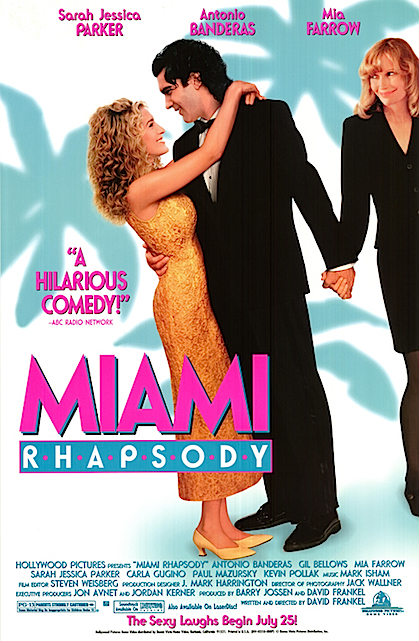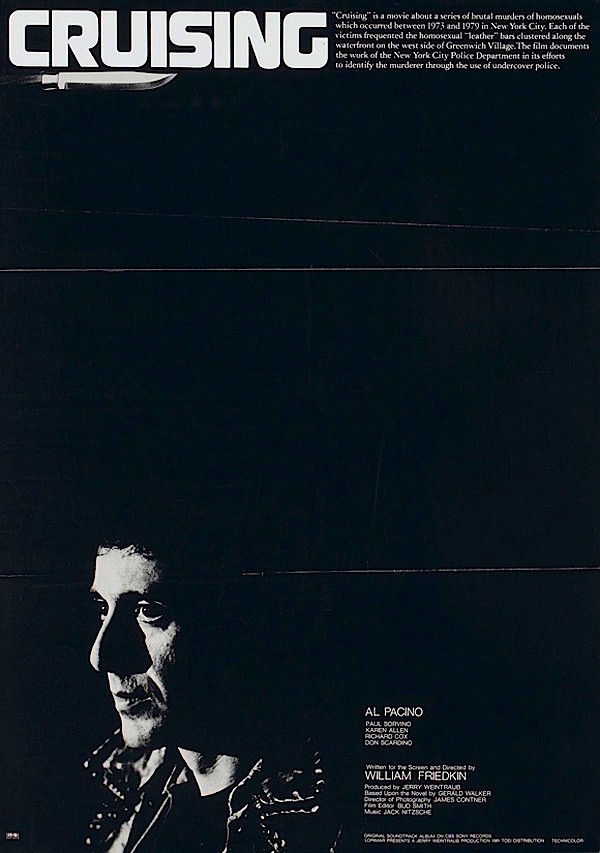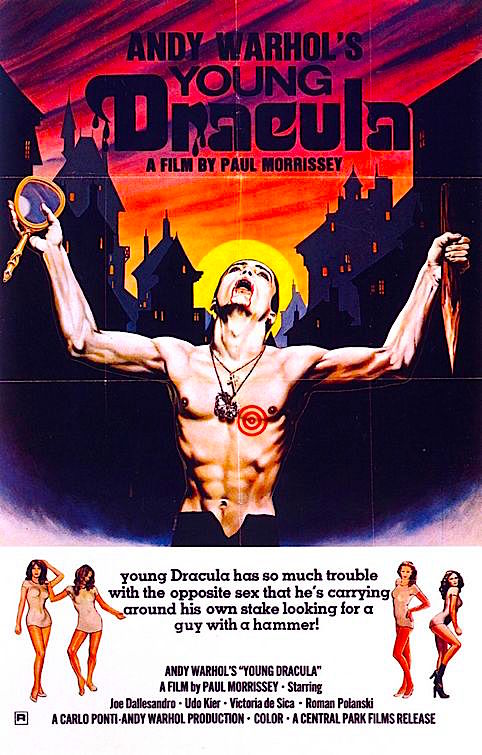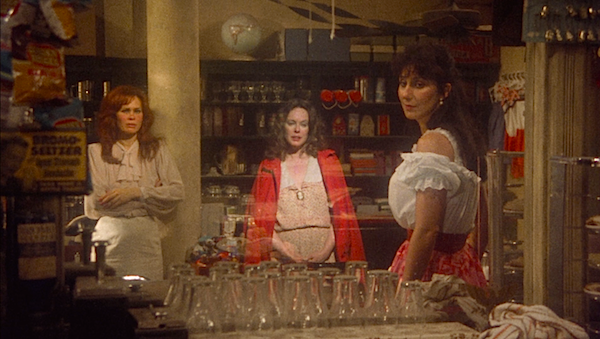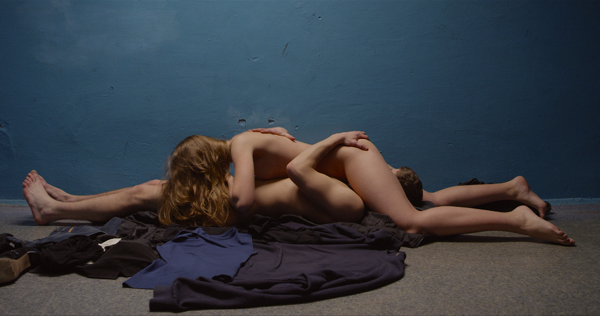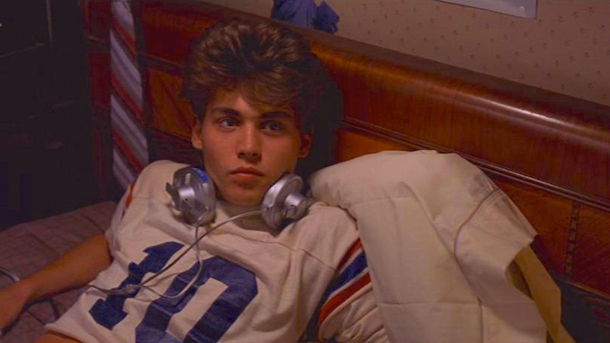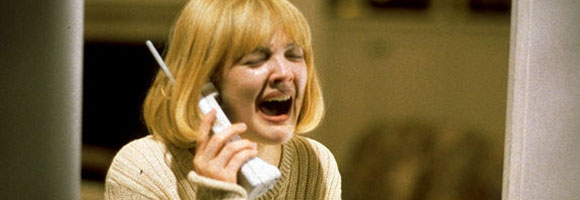Marshall McLuhan was a fascinating intellectual. He was also a scholar and philosopher who focused nearly all of his attention to the ways in which media does a great deal more than inform, sell or entertain. Almost 30 years before it was created, McLuhan predicted the concept of a “global village” or and electronic means of communication. In other words, the Canadian Media Theory Philosopher predicted what we now call The Internet.
If you are unfamiliar with the ideas put forward by McLuhan, here are a few quotes that highlight his ideas about the impact of media:
“In this electronic age we see ourselves being translated more and more into the form of information, moving toward the technological extension of consciousness.”
“Ideally, advertising aims at the goal of a programmed harmony among all human impulses and aspirations and endeavors. Using handicraft methods, it stretches out toward the ultimate electronic goal of a collective consciousness.”
“One of the effects of living with electric information is that we live habitually in a state of information overload. There’s always more than you can cope with.”
“Societies have always been shaped more by the nature of the media by which men communicate than by the content of the communication.”
“The medium is the message. This is merely to say that the personal and social consequences of any medium – that is, of any extension of ourselves – result from the new scale that is introduced into our affairs by each extension of ourselves, or by any new technology.”
McLuhan emerged as much a critic of media as he was in awe of a power that most could not see or simply seemed to to fully grasp. While “the medium is the message,” that message is continually elevating to newer and more invasive ways.

The Medium is the Massage: An Inventory of Effects
Marshall McLuhan, 1967 Graphic Design |Quentin Fiore
The continual evolution of medium’s technology is quickly escalating in it’s strength. Humankind is being manipulated in ways beyond the imagination. Individuality was / is losing ground. Is giving way to a formation of something more than “human” in the way we define ourselves.
“In this electronic age we see ourselves being translated more and more into the form of information, moving toward the technological extension of consciousness.” Marshall McLuhan
Marshall McLuhan’s ideas, theories, opinions and assertions are almost frightening in the ways one can chart the truth of what he stated in his lifetime. This great thinker died in 1980, yet his ideas remain alive and valid. To say he was ahead of the cultural curve would be an understatement.
As a Media Theorist, he had a great interest in television and motion pictures. Or, rather, an interest into what was actually being conveyed to audiences as they took in the information being “fed” into what was no longer simply the mind of the individual but the shared mind of those who watched and listened. By the mid-1970’s his ideas had well slipped into the intellectual mainstream as evidenced by his appearance as himself in Woody Allen’s Annie Hall in 1977.
In the surreal scene Allen’s character is able to invoke the presence of McLuhan to defend his personal opinion to an annoyingly loud fellow cinephile while they wait to see The Sorrow & The Pity:
“Wait a minute, why can’t I give my opinion? It’s a free country!”
“He can give it… do you have to give it so loud? I mean, aren’t you ashamed to pontificate like that? And the funny part of it is, Marshall McLuhan, you don’t know anything about Marshall McLuhan!”
“Oh, really? Well, it just so happens I teach a class at Columbia called ‘TV, Media and Culture.’ So I think my insights into Mr. McLuhan, well, have a great deal of validity!”
“Oh, do ya? Well, that’s funny, because I happen to have Mr. McLuhan right here, so, so, yeah, just let me —” [Allen pulls McLuhan into Gordon Willis’ frame] “Come over here for a second. tell him!”

“I heard what you were saying! You know nothing of my work! You mean my whole fallacy is wrong. How you got to teach a course in anything is totally amazing!”
Marshall McLuhan stands up for Alvey
Annie Hall
Woody Allen, 1977
Cinematography | Gordon Willis
While more than a few artists latched onto the ideas of Marshall McLuhan so did Film Theory, Philosophy and Journalism majors at universities across the world. But perhaps no intellectual and no artist latched onto McLuhan’s theories than fellow Canadian filmmaker, David Cronenberg.
“Art is anything you can get away with.” — Marshall McLuhan
From the very beginning, David Cronenberg pushed the ideas of Grindhouse Horror further than any other. Certainly, George A. Romero was interested in the ideas around how marketing and consumerism were rendering humans to a zombie like need that could never be fully satisfied.

“What are they doing? Why do they come here?”
“Some kind of instinct. Memory of what they used to do. This was an important place in their lives.”
Zombies roam the mall for live flesh as the new commodity.
Day of the Dead
George A. Romero, 1978
Cinematography | Michael Gornick
But it was Cronenberg who began to translate McLuhan’s ideas into a literal horror involving not only the way in which we think, but the way in which medium-saturated psychology could possibly morph into our biology.
Cronenberg was also way ahead of the cultural curve, when his low-budget gore-fests like 1975’s Shivers and 1977’s Rabid use the idea of sexual appetite and parasites or viruses merging to spread world-wide pandemics. Shivers is focused on a swinging singles apartment complex, but Rabid branches out into the world. A strange sort of gaping slip of a hole appears in the armpit, and the diseased seeks out sex partners to satisfy a painful urge. …and spread a disease.

A perplexing gape of wound appears on the body beautiful. Iconic Porn Star of the day goes legit as the sexy victim of disease which causes her to aggressively spread her sickness…
RABID
David Cronenberg, 1977
Cinematography | René Verzier
As silly as the gore might be in this movies, both carry a cerebral and visceral horror for viewers that remain today. We might giggle at some of the effects, but once these movies end the realization that we have seen two movies that seem to have predicted AIDS is impossible to dismiss. It is of particular interest that Cronenberg sought out the former Ivory Soap Girl turned Porn Superstar, Marilyn Chambers, to play the main carrier of the disease. A once symbol of Purity, Cleanliness & Innocence turned to Hardcore Media Porn Star Sinsation. The medium is the message…
In what can probably be considered Cronenberg’s first truly artistic horror film, 1979’s The Brood offers horror on several levels. In some ways this movie is a horror film about child-like killers. The site of these murderous little demons is delivered in a low-fi but intensely horrifying way.

Brooding literally births avenging demonic child-like killers intent on carrying the medium and message
The Brood
David Cronenberg, 1979
Cinematography | Mark Irwin
On another level, this surprisingly cerebral film offers a horror film related to the clinging fears left over from the 1960’s/1970’s revolutionary changes regarding individual freedoms and a culture in which patriarchal “control” over sexuality, marriage, children and our own individual minds was giving way to something that many felt sinister.
Oliver Reed’s Dr. Hal Raglan is a brilliant and charismatic sort of Psychiatry Guru (or Psychoplasmics Master) who has established a center for emotionally challenged individuals. A wife and mother with serious emotional issues has sought help, but has become a sort of Cult Slave to Dr. Raglan’s mad science experiments involving psychological anger.

Samantha Eggar broods her rage into full-fledged living beings designed to carry out her darkest violent urges.
The Brood
David Cronenberg, 1979
Cinematography | Max Irwin
Played by Samantha Eggar, this woman has learned to channel her rage into her core biology. Dr. Raglan is the medium. The message is an endless rage which morphs into stunted results of psycho-physcial pregnancies. She is not merely brooding anger, resentment and anger at her husband and a daughter who has perhaps prevented her evolution as an individual. No, she is literally brooding a number of angry beings birthed to carry out her inner insane rages. Under the work of the Mad Scientist, she is birthing the medium that seeks to destroy.
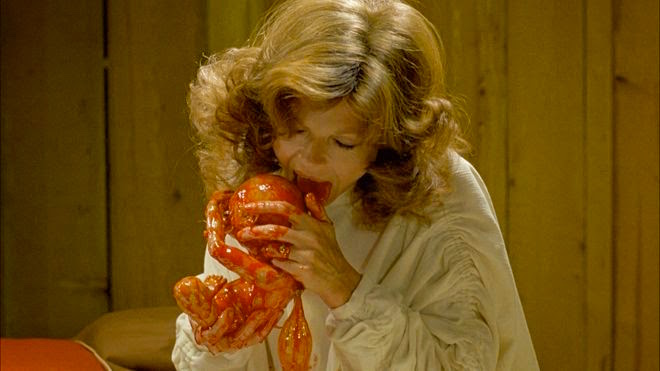
“Thirty seconds after you’re born you have a past and sixty seconds after that you begin to lie to yourself about it.”
Grooming a birth of insane rage… Body Horror taken to a whole new level.
The Brood
David Cronenberg, 1979
Cinematography | Max Irwin
The Brood suffers from limited budget, hammy acting and an idea that feels at once brilliant and a bit too silly. But we cannot forget that this is a David Cronenberg. The Brood is more than a partially scary and partially satirical cult movie — it sneaks in under our skin and into our shared thinking. This film lingers long after the comedic elements fade. Esteemed writer, Carrie Rickey, has pointed out that The Brood is also a startling counter-point to Kramer Vs. Kramer.
In 1981’s Scanners, David Cronenberg officially crossed over to mainstream success. No longer limited to Drive-In’s, Midnight Screenings or lower-rate cinemas — Scanners received a wide release.

Disturbing but creative art therapy isn’t enough for corporate interests…
Scanners
David Cronenberg, 1979
Cinematography | Max Irwin
And it not only changed the way we think of Science Fiction Horror, it elevated Cronenberg to a whole new level of artistic acceptance. It can also be closely linked to the ideology of Marshall McLuhan. Although the message is presented to humanity more in the form of 20th Century biochemicals than media. In Cronenberg’s Scanners, Diethylstilbestrol (DES) is not merely a carcinogenic, it has infected fetuses with a new sort of power. Thalidomide not only harms, it too causes a strange psycho-power mutation within infected fetal tissue of mothers treated with these chemicals.

“How do you feel?”
“I feel crystal clear.”
Heads do not roll. They explode.
Scanners
David Cronenberg, 1979
Cinematography | Max Irwin
Suddenly, Cronenberg’s much discussed Body Horror has elevated from human emotion to true biological horror. These infected mothers have given birth to children who have a new horrific telekinesis power. A power that can ultimately be controlled and used as a new kind of weapon. The film is best known for the effect of exploding heads, is actually going much deeper into human fear and horror ideology.
But it would be with Cronenberg’s 1983’s Videodrome that his interests in McLuhan’s teachings and the director’s own personal interest in the horror of the body turning against it’s owner would blend to form the almost perfect mix of Art Horror, Science Fiction, Surrealism and Cultural/Societal commentary.

“First it controls your mind…then it destroys your body”
France’s marketing campaign focused heavily on Debbie Harry
Videodrome
David Cronenberg, 1983
Cinematography | Max Irwin
Max Renn is the burned-out, bored but still ambitious CEO of a small Adults-Only cable company that seems posed to break big in the growing world of cable TV. Renn markets his cable channel as “The one you take to bed with you.” In 1983, audiences would have linked this fictional channel to the likes of Playboy TV or a wide range of latenight-only cable channels that offered soft porn and other provocative topics to it’s viewers.
Just slightly ahead of the game, the VHS industry was really only just starting to take-off across the mainstream. Players were only just starting to come down in price and the middle class had only dipped a few toes into the video-stream. The battle between VHS and BetaMax had not even fully started.

Cyber-Punk Surrealism or Infected Brain Hallucination? James Wood’s is about to receive a whole new kind of “head”
Videodrome
David Cronenberg, 1983
Cinematography | Max Irwin
In the real world, these types of channels were facing a number of obstacles in presenting hardcore sex. It was limited to silly soft-porn movies or carefully edited hardcore sex movies to amped-up R-rated erotica. In Cronenberg’s film Max Renn is eager to push pass the rules. Seemingly latching onto McLuhan’s idea of art being what one can get away with, Renn no longer cares about the rules that restrict him from gaining a competitive edge in the erotic marketplace. His “ethical” stance is flawed. If compared to McLuhan’s concept, Renn has perverted the idea regarding art. For Renn, this is simply business.
Enter the oddly moralistic world of David Cronenberg. Sexuality is a lure that Cronenberg utilizes to pull the audience into his latest exploration in psychological horror. The use of sex is both titillating and perverse. In many ways, Videodrome is Cyber-Punk Horror that dares to call our erotic desires into both cinematic provocation as well as an almost moral judgement.

Cinematic Provocation. A strange group of people can only find sexual pleasure/release at the time of self-inflicted car collisions take place. The scars become more erotic than the body upon which they inflict.
Rosanna Arquette
CRASH
David Cronenberg, 1996
Cinematography | Peter Suschitzky
I stress almost because Cronenberg is expertly exploiting/selling sex as much as he thrusts our prurient interests to a questionable level. This was not the first time nor was it the last that this skilled filmmaker would use sexuality in a perplexing duality of human nature. There is always a strangely moralistic tie in all of Cronenberg’s films. Even in his adaptation of JG Ballard’s CRASH, he would tease the audience with subversive and perverse sexuality to arouse not only very dark eroticism, but to illicit a perverse joy in turning it back on the audience.
One of our first opportunities to understand this character is when we see him as a guest on a local channel chat show. The chat show host is clearly uncomfortable discussing the ever-expanding level of sexual explicitness on television, but she grins and bares it. Max is one of three guests. The second guest is Nicki Brand, played with a gleeful level of subversion by Cultural Icon, Debbie Harry. Nicki, like Max, sells sex. She is selling herself as a sort of Post-Feminist erotic answer to the “outmoded” concepts of Feminist Theory formed by Betty Friedan and Gloria Steinem. Her mode of medium is talk radio in which she dishes out pseudo-pop-psychology sexualized advice.

“What about it, Nicki? Is it socially positive?”
“Well, I think we live in overstimulated times. We crave stimulation for its own sake. We gorge ourselves on it. We always want more, whether it’s tactile, emotional or sexual.”
Feminist Theory gets a kink-reboot with Debbie Harry as Nicki Brand.
Videodrome
David Cronenberg, 1983
Cinematography | Max Irwin
Debbie Harry, at her own erotic prime and fame is the perfect actor for this role. At once intellectual and also a rather edgy erotic tease, she is like cat-nip for Max Renn. As the chat show host pulls them into a debate about the dark side of eroticism to the masses, it becomes clear that Nicki Brand isn’t really looking to counter-point Max Renn as much as to simply admit that she is fully aware of the “dangers” but not that concerned with falling prey. As she informs the host, “We live in over-stimulated times.” As Max begins to openly flirt with Nicki, the host is left in an even more comical unease.
She then turns away from her two sex-fueled guest to her scientific expert who refuses to appear on any other media than the television. Taken to a truly literal perspective, Professor Brian O’Blivion appears on a TV sitting on a coffee table by the host. As the increasingly nervous host attempts to interview O’Blivion it quickly becomes apparent that he is not going to fully connect with her.

Marshall McLuhan deconstructed: Dr. Brian O’Blivion only seems to respond…
Videodrome
David Cronenberg, 1983
Cinematography | Max Irwin
He seems to be watching her other two guests, but moves into a sort of intellectual rant about the powers of television media: He begins to offer an almost religious sort of speech that television will soon replace “our” reality. Completely ignoring his host, he begins to almost preach through the screen of his own TV image:
“The battle for the mind of North America will be fought in the video arena: the Videodrome. The television screen is the retina of the mind’s eye. Therefore, the television screen is part of the physical structure of the brain. Therefore, whatever appears on the television screen emerges as raw experience for those who watch it. Therefore, television is reality, and reality is less than television. The television screen is the retina of the mind’s eye.”
David Cronenberg was very clear that his created character of Dr. Brian O’Blivion is based soley on Marshall McLuhan and the esteemed Media Sociologist’s ideas. McLuhan’s teachings, ideas and concepts are all brought to the forefront of this highly entertaining and often disturbing film. While Cronenberg lays it all out in literal and visceral visual terms, nothing actually strays too far from the recently departed McLuhan.

James Woods’ Max Renn develops an odd itchy rash as he watches…
Videodrome
David Cronenberg, 1983
Cinematography | Max Irwin
Played with simultaneous sexy swagger and icky slimed confidence by James Woods, Max deals with the European Erotica Market as well as underground networks of slightly harder-edged porn from Asia. We catch glimpses of the new work he is considering for his channel. From his European connection, the work seems innocently decadent. From the seemingly illegal importation from Asia, the work seems to be a sexualization of ethnic stereotypes that are pushing toward sadistic erotic pleasures. For Max, these new erotica films might offer a bit more in the way of erotic explicitness and controversy — but they are not enough. He is looking for something more “dangerous” and “risky.”
Enter Max’s pal and tech wiz, who manages to catch a Malaysian signal of what appears to be very realistic torture porn. So realistic in presentation, there is a suspicion that what Max is seeing may be a true filming of snuff human cruelty. It is never fully clear to us if Max is fully “OK” with what he sees on a show that seems to be called Videodrome, but it is clear that the sadomasochistic is most definitely turning him on.
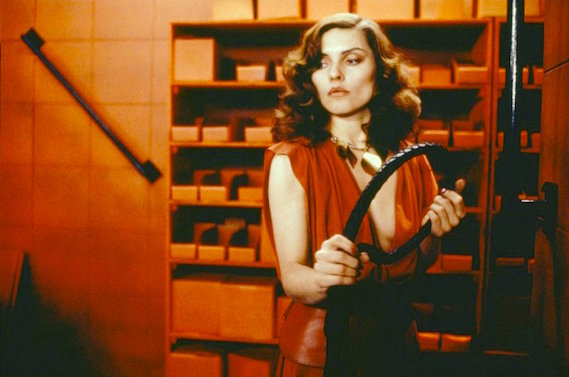
In 1983, it was shocking when Debbie Harry is suggested to supply a little bit of BDSM to get Max’s changing body stimulated. In 2015, this medium of BDSM has already become passively engrained within the cultural mind.
Videodrome
David Cronenberg, 1983
Cinematography | Max Irwin
He pushes his tech engineer to find the true origin of the Videodrome signal which turns out to be coming from Pittsburgh, Pennsylvania. Comforting himself by insisting that what he is seeing is a “pretend” electrically-charged clay wall and orange/red floors upon and against which acts of brutal sexual assaults and murders are carried out in realistic but fake ways. Max essentially threatens his libidinous European contact to find the creators of Videodrome to help him secure a deal to air their show. Soon later, his contact tries to soft talk him out of the idea. She advises that what he has been seeing is more than erotic entertainment.
She leans in as informs him that Videodrome has a philosophy. Videodrome is real.
At first Max refuses to believe it. His sexual relationship with Nicki is one linked to pain and punishment. It is all-the-more-hightened by a viewing of Videodrome. In a clever bit of Surrealism, Max and Nicki’s sexual blood-letting morphs out of Max’s condo and onto the wet red floor of the Videodrome set. Hallucinations give way to very real altercations in which Max’s body seems to be changing to fit into the psychology of Videodrome.

“Open up, Max. We have a tape we have a tape we need to play…”
Videodrome
David Cronenberg, 1983
Cinematography | Max Irwin
In one of the film’s many mind-bending special effects, Max begins to develop an itch resulting from what appears at first to be a an enflamed vertical line traveling down his “happy trail” that quickly emerges into a yon-like flesh entry point. Wet and wanting to be fed, this vaginal sort of “wound” becomes a portal in which Max and insidious Bad Guys place guns and breathing-infected videotapes. The pain of this “fleshy slit” also seems to deliver a source of uncomfortable pleasure. Eventually this body morphing develops teeth.
David Cronenberg’s Videodrome is a repulsive, intense and surreal Art Horror masterpiece that must be experienced to fully understand and enjoy. With each scene, the Videodrome transmissions seem to infect Max’s psychology, perception and ultimately his body.

A new point of entry to Max Renn… Body Horror taken to a whole new level.
Videodrome
David Cronenberg, 1983
Cinematography | Max Irwin
The ultimate body horror show, Max must either destroy the evil that is Videodrome and accept the new flesh it has created and take it forward to the next logical step. Many viewers interpret the film in different ways — particularly it’s apocalyptic ending. But it seems to me that David Cronenberg is pushing Marshall McLuhan’s ideology in very literal way. Fully infected by media’s disease, Max must refuse to submit to a vile corporate plan. He must take back what the medium has communicated into his very being.
“Death to Videodrome! Long live the new flesh!”
David Cronenberg has not only gotten away with creating a powerful and lasting work of film art, his horror film navigates the audience into a whole different sort of human universe. Video/Analog may have given way to HD/Digital, but the message of the medium is still every bit as worrying to us in 2015 as it was in 1983. The power of media is inescapable now more than ever. Paranoia and the threat of disease is at all time high.
Vidoedrome is far more than a Cult Horror Film Classic, it is a very warped, twisted and disturbing cinematic philosophy not to be be forgotten.

“Death to Videodrome. Long live the New Flesh.” Now, come to Nicki…
Debbie Harry
Videodrome
David Cronenberg, 1983
Cinematography | Max Irwin
Matty Stanfield, 9.28.15






















